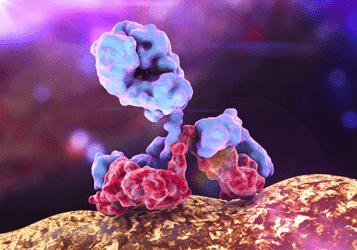- Home
- Products
- Customized ADCs
- CDH3
- Anti-CDH3-sulfo-SMCC-DM1SMe ADC
Anti-CDH3-sulfo-SMCC-DM1SMe ADC (CAT#: ADC-W-208)
This ADC product is comprised of an anti-CDH3 monoclonal antibody conjugated via a sulfo-SMCC linker to DM1SMe. The DM1SMe is targeted to certain cancers by immunerecognition and delivered into cancer cells via receptor mediated endocytosis. Within the cell, DM1SMe binds to tubulins, interrupts microtubule dynamics, and subsequently, induces cell death.
- ADC Target
- ADC Antibody
- ADC Linker
- ADC payload drug
- Name
- CDH3
- Alternative Names
- CDH3; cadherin 3, type 1, P-cadherin (placental); CDHP; HJMD; PCAD; cadherin-3; calcium-dependent adhesion protein, placental;
- Target Entrez Gene ID
- 1001
- Target UniProt ID
- P22223
- Overview
- This gene is a classical cadherin from the cadherin superfamily. The encoded protein is a calcium-dependent cell-cell adhesion glycoprotein comprised of five extracellular cadherin repeats, a transmembrane region and a highly conserved cytoplasmic tail. This gene is located in a six-cadherin cluster in a region on the long arm of chromosome 16 that is involved in loss of heterozygosity events in breast and prostate cancer. In addition, aberrant expression of this protein is observed in cervical adenocarcinomas. Mutations in this gene have been associated with congential hypotrichosis with juvenile macular dystrophy.
- Overview
- Chimeric Anti-CDH3 antibody
- Species Reactivity
- Human
- Name
- sulfo-SMCC (sulfosuccinimidyl 4-(N-maleimidomethyl) cyclohexane-l-carbox late)
- Description
- Noncleavable linkers, is considered noncleavable-meaning linker cleavage, and payload release does not depend on the differential properties between the plasma and some cytoplasmic compartments. Instead, the release of the cytotoxic drug is postulated to occur after internalization of the ADC via antigen-mediated endocytosis and delivery to lysosomal compartment, where the antibody is degraded to the level of amino acids through intracellular proteolytic degradation.
- Name
- DM1SMe
- Description
- Derived from Maytansinoid,a group of cytotoxins structurally similar to rifamycin, geldanamycin, and ansatrienin. The eponymous natural cytotoxic agent maytansine is a 19-member lactam (ansa
macrolide) structure originally isolated from the Ethiopian shrub Maytenus ovatus. Maytansinoids can bind to tubulin at or near the vinblastine-binding site, which interfere the formation of microtubules and depolymerize already formed microtubules, inducing mitotic arrest in the intoxicated cells.
For Research Use Only. NOT FOR CLINICAL USE.
Related Products
- Anti-CD40LG (Ruplizumab)-MC-MMAF ADC (CAT#: ADC-W-916)
- Anti-ITGA4 (Etrolizumab)-MC-MMAF ADC (CAT#: ADC-W-1474)
- Anti-TNFRSF9 (Urelumab)-MC-MMAF ADC (CAT#: ADC-W-1894)
- Anti-CD27 (Varlilumab)-MC-Vc-PAB-SN38 ADC (CAT#: ADC-W-2226)
- Anti-C-kit-SMCC-DM1 ADC-3 (CAT#: ADC-W-071)
- Anti-TPBG-hydroxyl amino PEG-MMAD ADC-1 (CAT#: ADC-W-312)
- Anti-MUC16 (Oregovomab)-MC-MMAF ADC (CAT#: ADC-W-1648)
- Anti-APP (Ponezumab)-SPDB-DM4 ADC (CAT#: ADC-W-711)
- Anti-IAV HA (Diridavumab(CR6261))-MC-Vc-PAB-MMAE ADC (CAT#: ADC-W-2069)
- Anti-CD248 (Ontuxizumab)-MC-Vc-PAB-SN38 ADC (CAT#: ADC-W-810)
Published Data
+ Submit Publications

Scientific Resources
Customer Reviews and FAQs
There are currently no Customer reviews or questions for ADC-W-208. Click the button above to contact us or submit your feedback about this product.
Quick Links
Other Products
Same Linker
| CAT# | Product Name | Linker | Payload |
| ADC-W-054 | Anti-FGFR2-sulfo-SMCC-DM1 ADC-4 | sulfo-SMCC (sulfosuccinimidyl 4-(N-maleimidomethyl) cyclohexane-l-carbox late) | DM1 (N2’-Deacetyl-N2’-(3-mercapto-1-oxopropyl)maytansine) |
| ADC-W-063 | Anti-FGFR2-sulfo-SMCC-DM1 ADC-13 | sulfo-SMCC (sulfosuccinimidyl 4-(N-maleimidomethyl) cyclohexane-l-carbox late) | DM1 (N2’-Deacetyl-N2’-(3-mercapto-1-oxopropyl)maytansine) |
| ADC-W-062 | Anti-FGFR2-sulfo-SMCC-DM1 ADC-12 | sulfo-SMCC (sulfosuccinimidyl 4-(N-maleimidomethyl) cyclohexane-l-carbox late) | DM1 (N2’-Deacetyl-N2’-(3-mercapto-1-oxopropyl)maytansine) |
| ADC-W-056 | Anti-FGFR2-sulfo-SMCC-DM1 ADC-6 | sulfo-SMCC (sulfosuccinimidyl 4-(N-maleimidomethyl) cyclohexane-l-carbox late) | DM1 (N2’-Deacetyl-N2’-(3-mercapto-1-oxopropyl)maytansine) |
| ADC-W-060 | Anti-FGFR2-sulfo-SMCC-DM1 ADC-10 | sulfo-SMCC (sulfosuccinimidyl 4-(N-maleimidomethyl) cyclohexane-l-carbox late) | DM1 (N2’-Deacetyl-N2’-(3-mercapto-1-oxopropyl)maytansine) |
Online Inquiry
Welcome! For price inquiries, please feel free to contact us through the form on the left side. We will get back to you as soon as possible.



